|

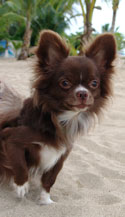 Two of a Kind: The AKC (American Kennel Club) recognizes two varieties of Chihuahua: the long-coat and the smooth-coat. Many smooth-coat Chihuahuas have very thin hair, but other smooth coats have a very dense, thick coat. Two of a Kind: The AKC (American Kennel Club) recognizes two varieties of Chihuahua: the long-coat and the smooth-coat. Many smooth-coat Chihuahuas have very thin hair, but other smooth coats have a very dense, thick coat.
Breed standards: Breed standards for this dog do not generally specify a height, only a weight and a description of their overall proportions. As a result, height varies more than other breeds. Generally, the height ranges between six and ten inches at the withers. However, some dogs grow as tall as twelve to fifteen inches. AKC show dogs must weigh no more than six lb (2.7 kg); the FCI standard calls for dogs ideally between 1.5 and three kg (3.3 to 6.6 lb), although smaller ones are acceptable in the show ring. However, pet-quality Chihuahuas (that is, those bred or purchased as
companions rather than show dogs) can, and do, range above these weights, to ten pounds or even more if they have large bone structures or are allowed to become overweight. This does not mean they are not purebred Chihuahuas, it only means that they do not meet the requirements to enter a conformation show. Oversize Chihuahuas are seen in some of the best and worst bloodlines.
Colors: Chihuahuas come in many colors, from solid blacks to solid whites, spotted, or a variety of other colors like fawn (tan), chocolate, blue (gray), silver, tricolored (chocolate, blue, or black with tan and white markings), brindle, and merle. And each of these colors vary in shades and tones,
as fawn can be a term to describe a tan dog from a very pale cream to a deep (almost red) tan, or any shade in between, and the chocolate coloration can range from a milky light shade of brown, to a deep mahogany brown, to a dark brown that is almost black.

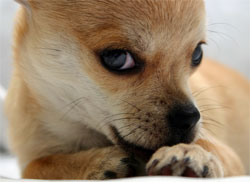 Personality: Chihuahuas are prized for their devotion and personality. Their alertness, intelligence and size make them easily adaptable to a variety of environments, including the city and small apartments, and they often live fifteen years or more. While Chihuahuas are often thought of as high-strung and fragile, correct training and socialization can result in an outstanding companion animal. Personality: Chihuahuas are prized for their devotion and personality. Their alertness, intelligence and size make them easily adaptable to a variety of environments, including the city and small apartments, and they often live fifteen years or more. While Chihuahuas are often thought of as high-strung and fragile, correct training and socialization can result in an outstanding companion animal.
Chihuahuas are not well-suited as small children's pets because of their size and physical fragility. Many Chihuahuas focus their devotion on one person, becoming overly jealous of that person's human relationships. However, this can be mitigated by thorough socialization. Chihuahuas also tend to have a "clannish" nature, often preferring the companionship of other Chihuahuas over other dogs. On the other hand, Chihuahuas seem to have no concept of their own size, and may fearlessly confront larger animals, which can result in injury.
Dressed for the Cold: Many Chihuahuas are sensitive to the cold due to their small body size. Chihuahua owners often dress their dogs in sweaters or coats in cold weather.

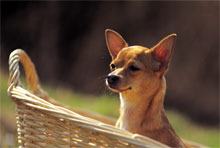 Smallest isn't Always Best: Some breeders of Chihuahuas purposely attempt to breed very small animals, and increase the prices of the smallest dogs, or specifically advertise tiny animals. Most reputable breeders disapprove of such practices, pointing out that it is difficult to predict the adult size of a given puppy, and citing the other issues discussed above. Smallest isn't Always Best: Some breeders of Chihuahuas purposely attempt to breed very small animals, and increase the prices of the smallest dogs, or specifically advertise tiny animals. Most reputable breeders disapprove of such practices, pointing out that it is difficult to predict the adult size of a given puppy, and citing the other issues discussed above.

Chihuahua Background: Chihuahuas were originally thought to be descendants of an ancient, similar, but slightly larger breed associated with royalty in Aztec civilizations known as the Techichi. However, due to the lack of archaeological remains, it is now believed that Chihuahuas were brought to Mexico by Spanish settlers. The most current theory holds that Spanish merchants brought Chihuahuas to Spain by way of their trade routes with China and from there to Mexico. The well documented practice in China of dwarfing both plants and animals is the basis for the theory that Chihuahuas originated there. But another theory is that they originated in Egypt and were traded into Spain and later Mexico. Chihuahuas were first taken into the United States by American visitors to Mexico.
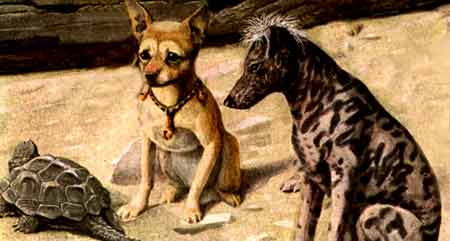
Health: This breed requires expert veterinary attention in areas such as birthing and dental care. Chihuahuas are also prone to some genetic anomalies, often neurological ones, such as epilepsy and seizure disorders. Chihuahuas, and other toy breeds, are also prone to the sometimes painful condition known as patella luxation. Another genetic abnormality in Chihuahuas and toy breeds is hydrocephalus, or water on the brain. This condition surfaces in young puppies and often results in the death of a puppy by the time that it reaches six months of age. It is thought that this disease is often diagnosed by the pup having an abnormally large head during the first several months of life, but other symptoms are more noticeable (since "a large head" is such a broad description). Chihuahua puppies exhibiting hydrocephalus usually have patchy skull platelets rather than a solid bone, and typically are lethargic and do not grow at the same pace as their siblings. A true case of Hydrocephalus can be diagnosed by a veterinarian, though the prognosis is grim.
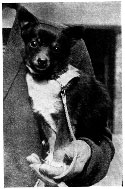 A Soft Spot: Chihuahuas are also known for their moleras, a soft spot in their skulls. Chihuahuas are the only breed of dog to be born with an incomplete skull. The molera does fill in with age, but great care needs to be taken during the first six months until the skull is fully formed. Many veterinarians are not familiar with Chihuahuas as a breed, and mistakenly confuse a molera with hydrocephalus. The Chihuahua Club of America has issued a statement regarding this often deadly misdiagnosis. A Soft Spot: Chihuahuas are also known for their moleras, a soft spot in their skulls. Chihuahuas are the only breed of dog to be born with an incomplete skull. The molera does fill in with age, but great care needs to be taken during the first six months until the skull is fully formed. Many veterinarians are not familiar with Chihuahuas as a breed, and mistakenly confuse a molera with hydrocephalus. The Chihuahua Club of America has issued a statement regarding this often deadly misdiagnosis.
Eyes: Chihuahuas are also prone to eye infections due to their large, round, protruding eyes and their relatively low ground clearance.
Genetic Disorders: Chihuahuas with two merle parents, may experience additional health complications. The Merle coat pattern is a carrier of possible severe eye conditions and blindness, deafness, hemophilia, sterility, and numerous other health concerns. Buyers owning or wishing to purchase a merle Chihuahua should do extensive research on the possible health concerns of this coloration.
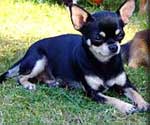 Healthy Weight: Chihuahuas are sometimes picky eaters, and care must be taken to provide them with adequate nutrition. At the same time, care must be exercised not to overfeed this tiny breed. And the Chihuahua can sometimes be very difficult to resist. Overweight Chihuahuas are prone to joint injuries, tracheal collapse, chronic bronchitis, and shortened Healthy Weight: Chihuahuas are sometimes picky eaters, and care must be taken to provide them with adequate nutrition. At the same time, care must be exercised not to overfeed this tiny breed. And the Chihuahua can sometimes be very difficult to resist. Overweight Chihuahuas are prone to joint injuries, tracheal collapse, chronic bronchitis, and shortened
life span.
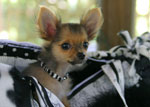 Cult of the Small: Along with "mini," "pocket" and "tiny toy", "teacup" is sometimes used to describe Chihuahuas and other dogs that are very small. These and similar terms are not officially used by any kennel club or reputable breeder, and are not breeds or specific types of Chihuahua. In particular, all Chihuahuas are toy dogs; there is no such thing as a "toy Chihuahua." Cult of the Small: Along with "mini," "pocket" and "tiny toy", "teacup" is sometimes used to describe Chihuahuas and other dogs that are very small. These and similar terms are not officially used by any kennel club or reputable breeder, and are not breeds or specific types of Chihuahua. In particular, all Chihuahuas are toy dogs; there is no such thing as a "toy Chihuahua."
Some potential buyers seek extremely small animals; very small dogs, however, are often runts. They may be unhealthy, or undernourished, or, if otherwise healthy, may suffer shortened life spans and health problems due to extreme dwarfing. They are not normally suitable for breeding, and may require special care.
Famous Chihuahuas:
* Tinkerbell Hilton, Paris Hilton's pet, and author of "Tinkerbell Hilton Diaries."
* Bruiser, Elle Woods' pet in the Legally Blonde movies.
* Gidget, the Taco Bell mascot.
* Ren Höek, of Ren and Stimpy fame.
* Wheely Willy, a motivational "speaker."
* Tito from Oliver & Company.
* Taquito, the University of Puerto Rico's School of Medicine volleyball mascot.
* The Spooky Chihuahua from Invader Zim.
* Pepito, Xavier Cugat's chihuahua immortalized in the children's book Pepito the Little Dancing Dog: The Story of Xavier Cugat's Chihuahua.
* Godzilla, a South Texas chihuahua that has won many awards in regional dog shows, and is now famous in its statewide commercials.
* Coco, Cesar Millan's The actor, dog behaviorist of The Dog Whisper by National Geographic.
* Pancho, the "heart-broken" dog of the Fullers in the movie Big Momma's House 2.
* Lou, a chihuahua featured on the television show The Soup.
* Clay, the current longhaired Chihuahua ambassador.
All text is available under the terms
of the GNU Free Documentation License
|
